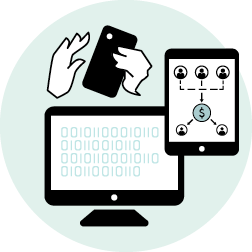Customers expect streamlined shopping experiences across different channels—in your store, online, and on-the-go. While online marketplaces like Amazon continue to improve and enhance the customer journey, you can do the same for your e-commerce website.
A PYMNTS.com study shows that roughly 50% of customers will abandon the sale when they encounter friction on a website; conversely, those who find a seamless sales process are much more likely to complete the sale and will return for future transactions.
You can turn your website into an e-commerce asset. Here are five ways to remove the friction from online sales:
- Quick download. Few things are more frustrating than waiting for a site to load. According to Akamai, a two-second delay in a webpage loading time increases bounce rates by 103%. You can optimize your website by ensuring you have sufficient disk space, bandwidth, and memory. Additionally, be sure to compress high-resolution content of your product pages, landing pages, and sales pages.
- Simple design. Your website should be simple, consistent, and aesthetically pleasing with a good balance of white space. The graphics and content should work together to reduce friction as your customers complete the buying process. Make sure your site design is consistent across all of the site pages, including colors and fonts. Use professional, customizable templates with drag-and-drop features to get your website up and running in no time. Plus, you get a shopping cart integration that makes checking out as easy as one, two, three.
- Simple sales process. Eliminate decision fatigue by reducing the number of choices a customer has to make. Don’t overwhelm them with options that will frustrate and confuse them. That means being transparent in shipping prices, units in inventory, taxes, and fees. You can even enable a low stock notification on certain items on your website to manage the customer’s expectations.
- Eliminate shopping cart abandonment. Oftentimes, customers fill their shopping cart with your products, but they leave your site at the check-out page. Why does this happen? One reason is lack of payment choices. Payment options need to be communicated up front, easy to see, and easy to use. If someone is spending longer than usual on the check-out page, activate a time-based pop-up window with helpful tips to check out. If the customer has abandoned the sale, a feature like automatic cart recovery can send an email with special offers and discounts to salvage the sale.
- Mobile friendly. Make sure your site is optimized for mobile devices, including quick downloads. Place a call to action on the top of the screen in the conversion path for maximum visibility. Don't underestimate the power of a top navigation menu. Include security seals and symbols to foster trust. Avoid disruptive pop-up messages and sidebar navigation menus.
Remember, customers today are seeking frictionless shopping experiences in person and online. Your website can make it easy for them by eliminating roadblocks. Whether it’s a product or service, give your customers an optimized experience with your brand, and you’ll see increased sales and repeat business.



